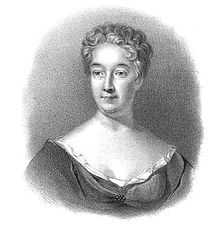Sophia Elisabet Brenner

Sophia Elisabet Brenner (née Weber) (29 April 1659 – 14 September 1730) was a Swedish writer, poet, women's rights activists and salon hostess, and was regarded in her country as a pioneer in each of these fields.
Biography
A daughter of the builder, Niklas Weber, and Kristina Spoor, she received an unusually fine education in her childhood, as her father obtained special permission for her to attend the German School for Boys in Stockholm. There, she was the first and only girl in the school, and learned six languages well enough to compose poetry in all of them. She was not, however, the first female student in Sweden; Ursula Agricola and Maria Jonae Palmgren had studied in the private School of Visingsö in 1644 and 1645 respectively.
In 1680, she married the miniaturist painter Elias Brenner and became the first Swedish salon hostess; among the Swedish elite who gathered in her salon were Aurora Königsmarck, the painter Anna Maria Ehrenstrahl, the poet Johan Runius and Urban Hjärne (who brought to an end the legal persecution of witches). Elias and Sophia had fifteen children, only four of whom survived her.
She became the first notable female poet as well as the first notable feminist in Sweden when she published "The justified defense of the female sex" in 1693, believed to be inspired by her friendship with Aurora Köningsmarck. In 1713 she published a collected edition of all her poems. She was called the "second Sappho", the "Tenth muse" and was regarded as Sweden's answer to other well-known female scholars of her time.
One of her works was a poem of admiration to the painter Anna Maria Ehrenstrahl, which also mentions her own activity as an artist and both of them as female artists:
If I of inborn instinct rimes for my pleasure,
Your inclination is made clear by your work.
For neither scare your pencil, nor my pen.
Though art may sometimes cost us hours,
There is no better way to be remembered by.
Let envy grine against us, let death tense his bow,
In the national Swedish portrait gallery of Gripsholm, which was opened in the 1820s, she was one of the first six women of the Swedish history who was given a portrait in the collection, along with Bridget of Sweden, Hedvig Charlotta Nordenflycht, Barbro Stigsdotter (Svinhufvud), Sophia Rosenhane and Vendela Skytte.
See also
- Catharina Ahlgren
- Hedvig Charlotta Nordenflycht
- Johanna Eleonora De la Gardie
- Aurora Liljenroth
- Hedvig Catharina Lilje
External links
- http://lu-research.lub.lu.se/php/gateway.php?who=lr&method=getfile&file=archive/00027329/
- http://www.coronetbooks.com/books/new/lett1574.html
- http://www.sophiabrenner.se/
References
- Steinberg, S.H. "Brenner, Sofia Ekisabet, née Weber." Cassell's Encyclopedia of World Literature. New York: Funk & Wagnalls, 1953.
- Nils Bohman,Svenska män och kvinnor del 1, (In Swedish)
- Litteraturens historia i Sverige, Bernt Olsson and Ingemar Algulin, (In Swedish).
- Carin Österberg, "Svenska kvinnor", (In Swedish).
- http://runeberg.org/sqvinnor/0147.html
- A.L. Stjerneld (anonym), Gripsholmgalleriet (Stockholm 1833)
|